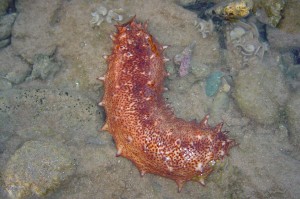We have discussed the cleanup crew including the different snails an herbivores eaters. Get your tank set for another caretaker of reef tanks, the sea cucumber.
Sea cucumbers are echinoderms belonging to the class Holothuroidea. They are marine animals featuring a leathery skin and an extended body containing a single, branched gonad. They are extensively found on the sea floor globally.
The biggest controversy on sea cucumbers is whether or not they should be kept in a reef aquarium or a fish only aquarium. Here we shall be considering both its positive and negative aspects.
We have discussed the cleanup crew including the different snails and herbivores eaters. Get your tank set for another caretaker of reef tanks, the sea cucumber.
Sea cucumbers are echinoderms belonging to the class Holothuroidea. They are marine animals featuring a leathery skin and an extended body containing a single, branched gonad. They are extensively found on the sea floor globally.
The biggest controversy on sea cucumbers is whether or not they should be kept in a reef aquarium or a fish only aquarium. Here we shall be considering both its positive and negative aspects.
Let’s consider the fear factor first. The reason why aquarists dread keeping sea cucumbers in their marine tank is for its capability to disembowel itself and discharge of different toxins that are found to destroy all the fish in a reef or fish-only tank. For example some of these species are known to force their cuvierian tubules, a part of their respiratory system out their anus as a type of sticky, stringy maze to guard them from intimidating creatures. Some sea cucumbers can also eject parts of their digestive system as a security method or a reaction to ecological stressors. Though sources say that they do it only seasonally, it is difficult to determine which species carry this out in which season. The evisceration process is not always followed by chemical expulsion, but when it is, chances are that it will have dreadful effect on the fishes and habitants of the tank.
The good part is that the sea cucumbers are sand-feeding creatures that help keep the top layer of the sand bed clean and good looking. Some species are known to consume the top layer of sand, clean the fine grains and then expel it. They can clear your tank from the various nuisance algae too. Various aquarists have reported of successfully maintaining some species of sea cucumber in their reef tank with a few precautions. They are literally inexpensive and are available almost anywhere in a local marine shop. You do not have to feed it any extra as it takes its nutrition from the left over and wastes of fishes. This way they also contribute towards prevention of algae bloom. It is reported that a tank containing a sea cucumber remains algae and pest free.
Coming back to the debate, so is sea cucumber apt for reef tanks? The answer lies in the fact that some species of these creatures are less toxic and can be easily maintained with other inhabitants of the tank. Some of the species are hazardous and are a strict no for reef tanks. Sand-feeding turd cukes are less toxic than the colorful filter feeders.
The concentrations and assortment of toxic chemicals found in the Aspidochirotiacea, the group that includes the sand-feeding cucumbers is usually lower than those of the Dendrochirotacea, the group that includes most of the colorful suspension feeding cucumbers.
The best way to ascertain the right sea cucumber for your tank is to buy them from a good source. If you are unsure, better avoid it than experimenting with the lives of fishes. If you already have one, make sure you keep a good level of sand bed in your tank. Keep only one sea cucumber for every 50 to 75 gallons tank. More than that will create unnecessary trouble. Keep the water change procedure regular and Make sure all powerheads and intakes are roofed. And the last precaution to be taken is never to keep triggerfish, Wrasses, Butterfly fish, and large hermit crabs with sea cucumbers.




